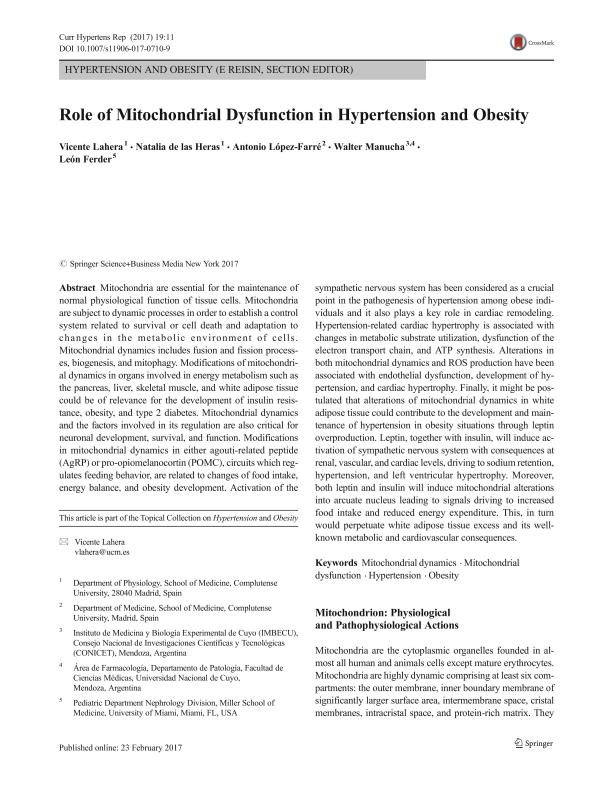Artículo
Role of Mitochondrial Dysfunction in Hypertension and Obesity
Lahera Juliá, Vicente; de Las Heras, Natalia; López Farré, Antonio; Manucha, Walter Ariel Fernando ; Ferder, León
; Ferder, León
 ; Ferder, León
; Ferder, León
Fecha de publicación:
02/2017
Editorial:
Current Medicine Group
Revista:
Current Hypertension Reports
ISSN:
1522-6417
e-ISSN:
1534-3111
Idioma:
Inglés
Tipo de recurso:
Artículo publicado
Clasificación temática:
Resumen
Mitochondria are essential for the maintenance of normal physiological function of tissue cells. Mitochondria are subject to dynamic processes in order to establish a control system related to survival or cell death and adaptation to changes in the metabolic environment of cells. Mitochondrial dynamics includes fusion and fission processes, biogenesis, and mitophagy. Modifications of mitochondrial dynamics in organs involved in energy metabolism such as the pancreas, liver, skeletal muscle, and white adipose tissue could be of relevance for the development of insulin resistance, obesity, and type 2 diabetes. Mitochondrial dynamics and the factors involved in its regulation are also critical for neuronal development, survival, and function. Modifications in mitochondrial dynamics in either agouti-related peptide (AgRP) or pro-opiomelanocortin (POMC), circuits which regulates feeding behavior, are related to changes of food intake, energy balance, and obesity development. Activation of the sympathetic nervous system has been considered as a crucial point in the pathogenesis of hypertension among obese individuals and it also plays a key role in cardiac remodeling. Hypertension-related cardiac hypertrophy is associated with changes in metabolic substrate utilization, dysfunction of the electron transport chain, and ATP synthesis. Alterations in both mitochondrial dynamics and ROS production have been associated with endothelial dysfunction, development of hypertension, and cardiac hypertrophy. Finally, it might be postulated that alterations of mitochondrial dynamics in white adipose tissue could contribute to the development and maintenance of hypertension in obesity situations through leptin overproduction. Leptin, together with insulin, will induce activation of sympathetic nervous system with consequences at renal, vascular, and cardiac levels, driving to sodium retention, hypertension, and left ventricular hypertrophy. Moreover, both leptin and insulin will induce mitochondrial alterations into arcuate nucleus leading to signals driving to increased food intake and reduced energy expenditure. This, in turn would perpetuate white adipose tissue excess and its well-known metabolic and cardiovascular consequences.
Palabras clave:
Hypertension
,
Mitochondrial Dynamics
,
Mitochondrial Dysfunction
,
Obesity
Archivos asociados
Licencia
Identificadores
Colecciones
Articulos(IMBECU)
Articulos de INST. DE MEDICINA Y BIO. EXP. DE CUYO
Articulos de INST. DE MEDICINA Y BIO. EXP. DE CUYO
Citación
Lahera Juliá, Vicente; de Las Heras, Natalia; López Farré, Antonio; Manucha, Walter Ariel Fernando; Ferder, León; Role of Mitochondrial Dysfunction in Hypertension and Obesity; Current Medicine Group; Current Hypertension Reports; 19; 11; 2-2017; 1-9
Compartir
Altmétricas



